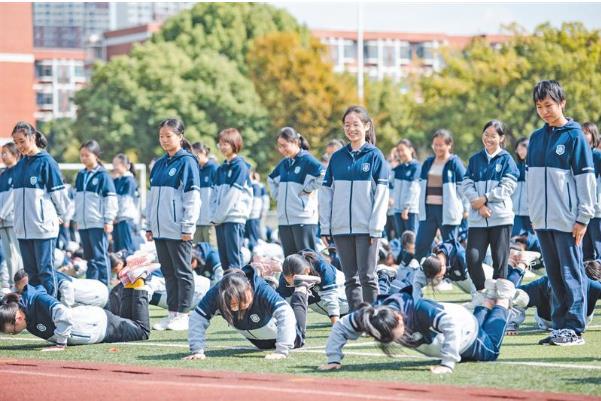
Jiangsu Xishan Senior High School in Wuxi, Jiangsu province, has made fitness a priority, requiring students to each day attend one PE class and exercise for at least an hour. [Photo/wxrb.com]
Sacrificing PE classes and sports time to focus on academic studies has long been the norm in Chinese schools. However, the rise in obesity, shortsightedness and other fitness-related problems among schoolkids in recent years has highlighted the importance of ensuring exercise forms an integral part of students' lifestyles.
Jiangsu Xishan Senior High School in Wuxi, Jiangsu province, is showing exactly how a better balance can be maintained, requiring all of its students to each day attend one PE class and exercise for at least an hour.
"If students can't achieve sufficient scores, they will fail the national college entrance exam. But if all they have is just high scores, they will probably fail the test of life," said the school's principal, Tang Jiangpeng, a member of the Chinese People's Political Consultative Conference National Committee, which convened for the annual two sessions earlier this month in Beijing.
"A good education should nurture those who make sports a lifelong habit, who can dare to take responsibilities, who can solve problems and who live fulfilling lives."
Tang told media that in 2020 the average height of first-grade male students in his school was 1.8 meters, with female students measuring an average 1.66m. Despite half of the male students being taller than the principal, very few of them could complete the school's chin-up test, and 132 boys couldn't even do one chin-up.
The principal also revealed that among the school's 893 first-grade students, 774 wear glasses.
Stats such as these are enough to show Tang that, far from being excessive, the school's exercise policy is absolutely necessary. After just one semester of sports classes, most students can now perform 50 push-ups in a minute, according to Tang.
"Before the sports classes, I could only do two to three chin-ups. But now I can easily finish 10," Zhang Kunpeng, a first-grade student, told China Sports Daily.
The school also offers students a varied sports curriculum, including basketball, volleyball, soccer, swimming, fencing and yoga, taught by a staff of 21 coaches, both domestic and foreign.
"I always believe the physical fitness of our students should be a priority of our work," said Tang. "During each day's sports hour, how to make the classes more scientific and effective, and what kind of results we want to achieve, are all aspects that we need to keep improving in the future."
Moreover, according to China Youth Daily, about 80 percent of kids in China lack after-school sports activities, while many parents still lack basic knowledge about the importance of a balanced diet.
"With the rapid development of China's economy, parents now focus more on the fitness and health of their children. Society as a whole now knows more about the value of sports," Wu Jian, an expert with the National Institute of Education Sciences, told China Youth Daily.
"The average height of an 18-year-old male in our country has reached 1.75m while the average height of a female is 1.65m. Despite the growth in the average height of our teenagers, many of them cannot run fast or jump high. Some of them have weight issues, some are facing scoliosis and many are shortsighted.
"We need better solutions. We should not only guarantee the one-hour sports time at school, we should also improve the quality of their sports classes. Apart from the efforts of schools, the parents should also encourage their kids to do more exercise."